ChatGPT for SEO? Six months ago, I was spending 4-5 hours researching keywords, outlining content, and writing meta descriptions for a single blog post. Today? I complete the same work in 90 minutes, and the quality is actually better.
The difference? ChatGPT.
But here’s what nobody tells beginners: Simply asking ChatGPT to “write an SEO article” is the fastest way to create generic, unrankable content that Google will ignore. After testing ChatGPT across 50+ SEO projects and analyzing what actually works in 2025, I’ve discovered the exact workflows, prompts, and strategies that move the needle.
Table of Contents
With 800 million weekly active users and generating 2.5 billion prompts daily, ChatGPT has become the most powerful SEO tool available. But power without strategy is useless.
In this guide, you’ll learn exactly how to use ChatGPT for SEO from keyword research to content creation, on-page optimization to link building with 30+ copy-paste ready prompts that you can use immediately. I’ll also share the mistakes that destroy results (so you can avoid them) and show you the real data behind what’s working right now.
What you’ll discover:
- How to use ChatGPT for keyword research that actually finds opportunities (not zero-volume keywords)
- The exact prompting framework that produces SEO content Google rewards
- ChatGPT vs Claude: Which AI tool wins for different SEO tasks
- 30+ copy-paste prompts for every SEO workflow
- Google’s real stance on AI content (it’s not what you think)
- Real case studies with traffic numbers and ROI data
- Critical mistakes that get your content penalized
By the end of this guide, you’ll have a complete ChatGPT for SEO system that cuts content production time by 60-70% while improving quality and rankings.
Let’s dive in.
What Makes ChatGPT for SEO is a Game Changer in 2025?
ChatGPT isn’t just another SEO tool, it’s a fundamental shift in how SEO work gets done. Here’s why it matters more than ever in 2025:
The Numbers Tell the Story
800 million people use ChatGPT every week, making it one of the fastest-growing platforms in history. For SEO professionals, this creates two massive opportunities:
First, ChatGPT as an SEO tool: 86% of enterprise SEO professionals have integrated AI into their strategy, with 61.90% using AI tools daily. The reason? ChatGPT delivers a 40% reduction in task completion time according to MIT research, while simultaneously improving output quality by 18%.
Second, ChatGPT as a traffic source: AI referral traffic surged 527% between January-May 2025. ChatGPT now sends 40-60% of all AI referral traffic, making it a discovery channel you can’t ignore. Traditional SEO still matters because ChatGPT uses Google SERP snippets for its answers, meaning ranking in Google helps you rank in ChatGPT.
What ChatGPT for SEO Actually Does Well (and Where It Fails)
After testing ChatGPT for SEO extensively, here’s the honest assessment:
ChatGPT excels at:
- Speed and scale: Generate 30 keyword variations in 10 seconds vs. 30 minutes manually
- Ideation and brainstorming: Produce 20 content angles when you’re stuck on one
- Repetitive tasks: Create 100 meta descriptions in the time it takes to write 5
- Data analysis: Interpret complex analytics and suggest improvements
- Technical SEO: Generate schema markup, hreflang tags, robots.txt rules
- Content structure: Build comprehensive outlines based on top-ranking content
ChatGPT struggles with:
- Factual accuracy: GPT-5 still has hallucinations (45% fewer than GPT-4o, but they still happen)
- Current data: Without web search enabled, knowledge cuts off at January 2025
- Original insights: Can only synthesize existing information, not create new research
- E-E-A-T signals: Cannot demonstrate genuine personal experience or expertise
- Search volume data: Keyword suggestions often have zero actual search volume
The key to success? Use ChatGPT as a strategic partner, not a replacement for human expertise.
GPT-5.1 and Latest Features You Need to Know
ChatGPT launched GPT-5 on August 7, 2025, bringing significant improvements for SEO work:
- 45% fewer hallucinations than GPT-4o (80% fewer when using reasoning mode)
- Better instruction following with 94.6% accuracy on complex tasks
- Extended context window of 128,000 tokens (about 96,000 words)
- ChatGPT Search provides real-time web data (launched October 31, 2024)
- Advanced Voice Mode for hands-free content creation and research
- Custom GPTs for specialized SEO workflows (3+ million created)
For beginners, the free tier offers: GPT-4o mini with limited GPT-5 access (10 messages every 5 hours), web browsing, file uploads, image generation, and data analysis. This is enough to start seeing real results.
ChatGPT Plus ($20/month) provides: 160 messages with GPT-5 every 3 hours, ChatGPT Search integration, Custom GPTs access, and priority responses. Worth it if you’re using ChatGPT for SEO work regularly.
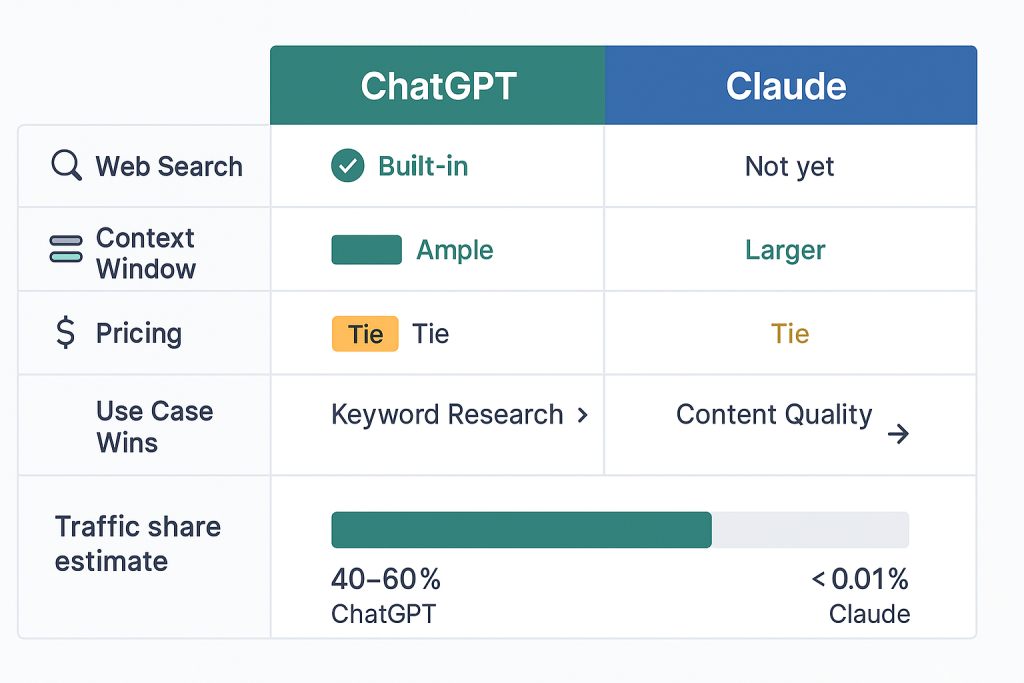
ChatGPT vs Claude: Which AI Wins for SEO?
This is the question I get asked most: “Should I use ChatGPT for SEO or Claude?”
After extensive testing with both tools, here’s the truth: You should use both strategically.
The Head-to-Head Comparison
ChatGPT wins for:
- Keyword research: Built-in web search provides current trends and real-time data
- Creative headlines: Generates more engaging, click-worthy titles
- Speed and iteration: Faster responses with multiple variations quickly
- Market dominance: 81% market share means more integrations and tools
- Traffic generation: Sends 40-60% of all AI referral traffic (vs Claude’s <0.001%)
Claude wins for:
- Content quality: More natural, human-like writing that sounds authentic
- Long-form content: Better coherence across 3,000+ word articles
- Context capacity: 200,000-1,000,000 token window vs ChatGPT’s 128,000
- Brand voice consistency: Maintains tone better across multiple pieces
- Session value: $4.56 per session (highest among AI tools)
The winning workflow: Use ChatGPT for keyword discovery and trend research, then feed that data to Claude for content creation and semantic analysis. This hybrid approach leverages each tool’s strengths.
As SE Ranking notes: “Many SEO professionals find that a hybrid approach brings the best results. You might use ChatGPT to generate a list of content ideas and then use Claude to expand one of those ideas into a thorough content brief.”
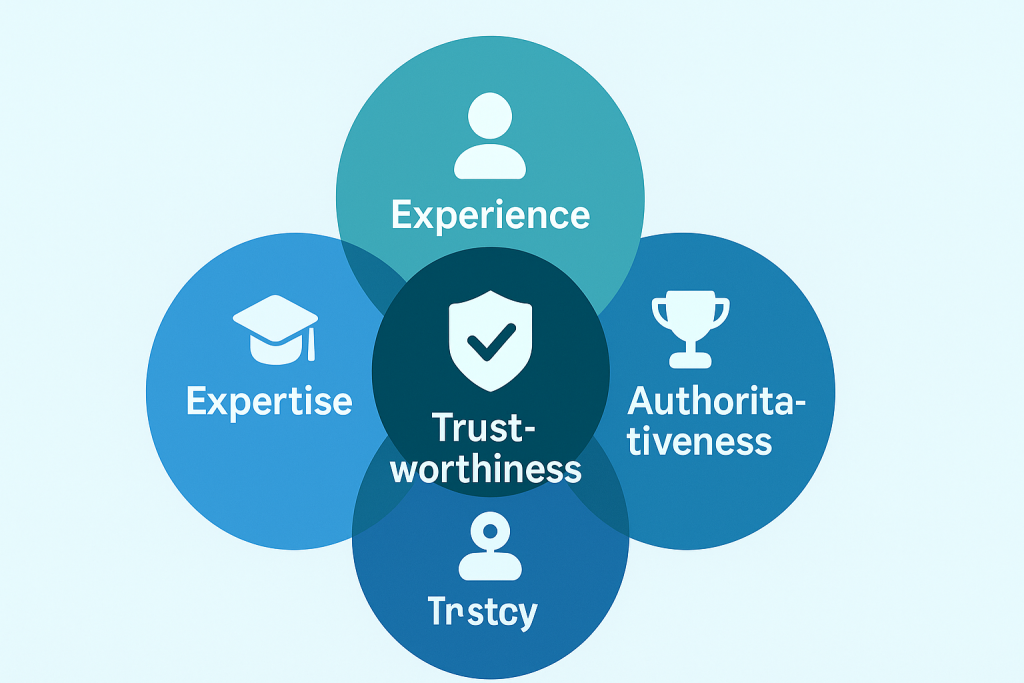
Is ChatGPT for SEO Content Against Google’s Guidelines?
Let’s address the elephant in the room: Will Google penalize my AI-generated content?
Here’s Google’s official position (February 2023, still current): “Appropriate use of AI or automation is not against our guidelines.”
What Google actually cares about: Quality and intent. The violation occurs when using AI “primarily to manipulate ranking in search results.” Content written to help people? Totally fine. Content mass-produced to game rankings? That’s the problem.
The E-E-A-T Framework (Your Quality Standard)
Google’s E-E-A-T framework is your North Star:
- Experience: First-hand or real-world interaction (AI’s biggest weakness)
- Expertise: Knowledge and skill in the subject
- Authoritativeness: Recognition as a go-to source
- Trustworthiness: Accuracy, honesty, safety (most important element)
The key insight: AI can help with Expertise (knowledge synthesis) but struggles with Experience (genuine personal insights). Your job is to add the Experience layer that makes content valuable.
What’s Actually Allowed vs. Prohibited
✓ DO – Acceptable patterns:
- Use AI for research, drafting, and ideation
- Generate first drafts with substantial human editing
- Automate repetitive tasks (meta descriptions, schema markup)
- Maintain human-in-the-loop workflow (AI generates → Human reviews → Human edits → Human approves)
- Consider disclosure when AI usage might be reasonably expected
✗ DON’T – Prohibited patterns:
- Mass-produce pages primarily to manipulate rankings
- Publish unreviewed AI output without editing
- Create generic content with no unique value
- Use keyword-stuffed, thin content
- Hide or obscure AI content creation
Important note: The March 2024 Core Update targeted low-quality AI content, resulting in 45% reduction in unoriginal content and mass deindexation of AI-heavy websites. Google can and does detect patterns of scaled content abuse.
Bottom line: ChatGPT for SEO content CAN rank and rank well if you focus on quality, add genuine expertise, and prioritize helping people over gaming algorithms.
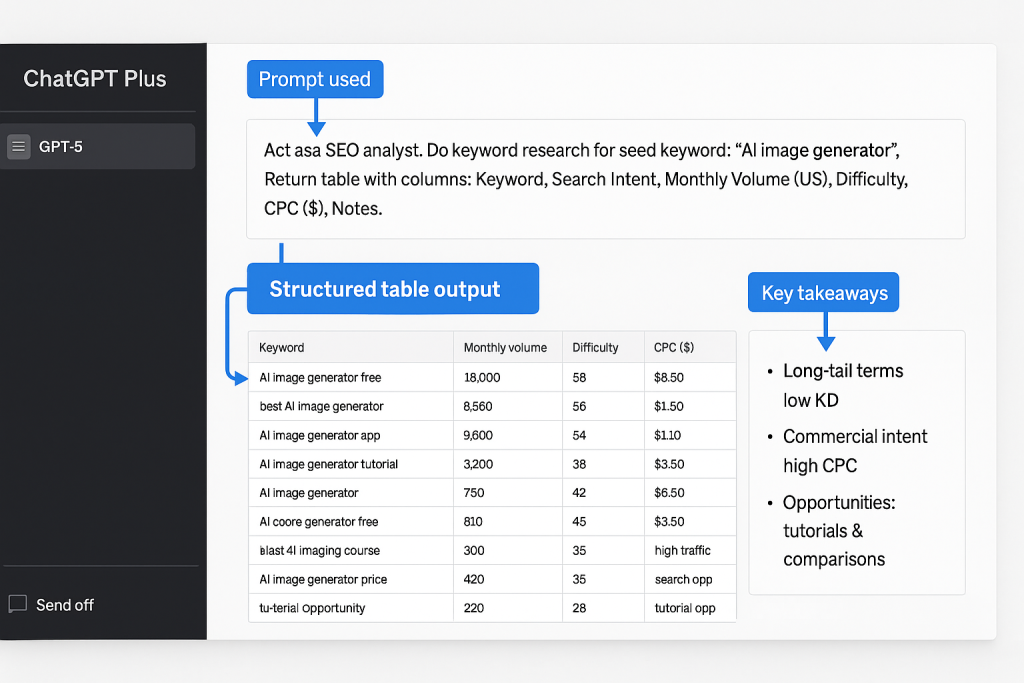
ChatGPT for Keyword Research: 10 Copy-Paste Prompts
Keyword research is where most beginners make their first mistake: trusting ChatGPT’s keyword suggestions without validation. Here’s how to do it right.
Critical Warning First
When Ahrefs tested ChatGPT for keyword research, they asked for “long-tail keywords for golf niche” and plugged all suggestions into Keywords Explorer. The result? ZERO search volume for all suggested keywords.
The fix: Use ChatGPT for ideation only, then validate every keyword in proper SEO tools (Ahrefs, SEMrush, or free Google Keyword Planner).
Prompt 1: Seed Keyword Generation
Give me 30 semantically relevant but unique topics under the main category of '[your niche]'. Give me the result in a table with 5 columns: Topic, Search Intent, Content Type, Difficulty Estimate, and Priority.
Example for my niche: digital marketing for small businessesWhat this does: Generates diverse topic ideas you might not have considered, organized for easy prioritization.
Prompt 2: Long-Tail Keyword Discovery
Using '[seed keyword]' as the central topic, identify 20 long-tail
keyword variations that potential customers might use when they're
looking for [specific solution/need].
For each keyword, include:
- Search intent (informational, commercial, or transactional)
- User pain point it addresses
- Content format that would best serve this query
Seed keyword: project management softwarePrompt 3: Question-Based Keywords
Generate 15 question-based keywords related to '[main topic]' that
beginners would ask.
Format as:
- The question
- Question type (What, How, Why, When, Where, Who)
- Likely user intent
- Brief answer angle
Main topic: SEO for e-commerceWhy this works: Question keywords often have lower competition and
align perfectly with FAQ content that ranks well.
Prompt 4: Keyword Clustering
Cluster the following keywords based on their semantic relevance and search intent.
Create topic groups with a core topic for each cluster.
Format the output as a table with columns: Cluster Name, Core Topic, Related Keywords,
Recommended Content Type
Keywords: [paste your keyword list]
Prompt 5: Search Intent Classification
For each keyword below, identify:
1. Primary search intent (Informational, Commercial Investigation,
Transactional, Navigational)
2. User goal (what they're trying to accomplish)
3. Best content type to target it (blog post, product page, comparison guide,
tutorial, tool, etc.)
4. Key elements that content should include
Keywords:
- [keyword 1]
- [keyword 2]
- [keyword 3]Prompt 6: Competitor Keyword Gap Analysis
I want to identify keyword opportunities where my competitors rank but I don't.
My website focuses on: [brief description]
My main competitor: [competitor URL or description]
Based on this information, suggest 10 keyword topics where:
1. The competitor likely has content
2. I'm missing coverage
3. There's opportunity for a beginner in my niche
For each topic, explain why it's a good opportunity.Prompt 7: Local SEO Keywords
Generate 15 local SEO keyword variations for a [business type] in [city/region]. Include:
- Service-based keywords ("plumber near me" style)
- Location modifiers
- Neighborhood-specific terms
- "Best [service] in [location]" variations
Business: coffee shop
Location: Portland, OregonPrompt 8: Keyword Translation for International SEO
I have these English keywords that perform well: [list keywords]
Translate these into [target language] considering:
- Local search behavior and colloquialisms
- Cultural relevance
- Regional variations
- Search volume likelihood
For each translation, note if the concept translates directly or needs adaptation.
Target language: Spanish (Mexico)Prompt 9: Seasonal Keyword Planning
Create a 12-month seasonal keyword strategy for [niche]. For each month, suggest:
- 3-5 timely keywords to target
- Why they're relevant that month
- Content type recommendation
- Lead time needed for content creation
Niche: fitness and wellnessPrompt 10: Branded vs. Unbranded Classification
Classify these keywords as either:
- Branded (include my brand name or product names)
- Competitor branded (include competitor names)
- Generic/unbranded (industry terms)
Then suggest the strategic priority for each group.
My brand: [brand name]
Main competitors: [competitor names]
Keyword list: [paste keywords]Pro tip: After using any of these prompts, always follow up with: “For the keywords you suggested, identify which ones I should validate first in a keyword research tool and why.”
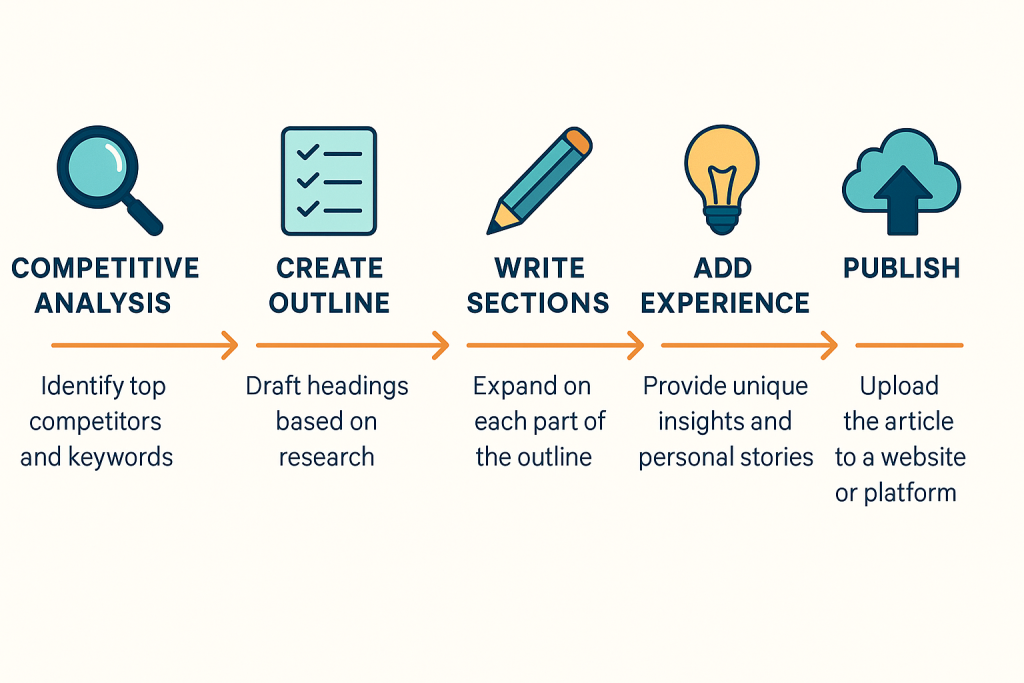
ChatGPT for SEO in Content Creation: The Complete Workflow
Creating SEO content with ChatGPT for SEO isn’t about asking it to “write an article.” It’s a strategic, multi-step process. Here’s the exact workflow that works.
The Fatal Mistake Most Beginners Make
❌ Wrong approach: “Write a 2000-word article about [keyword]”
Why it fails: Produces generic, flat content that lacks depth, expertise, and E-E-A-T signals. It sounds like every other AI article on the internet.
✓ Right approach: Strategic, multi-step process with human expertise layered throughout.
Step 1: ChatGPT for SEO in Competitive Analysis
Prompt:
Analyze the top 3 ranking articles for the keyword "[target keyword]".
For each article (I'll provide URLs or key points):
1. Main topics and subtopics covered
2. Unique angles or perspectives used
3. Content structure and format
4. What they're missing or doing poorly
5. Opportunities to create better content
Then suggest a content outline that:
- Covers everything the top articles include
- Adds unique value they're missing
- Provides a better user experience
- Targets beginner understanding level
Target keyword: how to start a podcastStep 2: Create SEO-Optimized Outline
Prompt:
Create a detailed SEO-optimized outline for an article titled "[your title]" targeting the keyword "[target keyword]".
Requirements:
- Target audience: [describe your audience]
- Word count goal: [target length]
- Tone: [professional/casual/technical/friendly]
- Include H2 and H3 structure
- Add specific points to cover under each section
- Include an FAQ section with 5-7 questions
- Suggest where to add examples, data, or case studies
- Note opportunities for internal linking
Primary keyword: [keyword]
Secondary keywords: [related keywords]Step 3: Write Section by Section (NOT All at Once)
Why section-by-section is better: Allows you to guide ChatGPT for SEO, maintain quality control, inject personal experience, and prevent generic output.
Prompt template per section:
Write the [section name] section for my article about "[topic]".
Context: This article helps [target audience] understand [main benefit/solution].
Requirements for this section:
- Length: [word count] words
- Start with [hook/stat/question/story]
- Include 2-3 specific examples
- Use conversational but professional tone
- Short paragraphs (2-3 sentences max)
- Include bullet points where helpful
- End with a transition to the next section
Do NOT use these overused AI phrases: "In today's digital landscape," "It's important to note," "Delve into," "Dive deep," "Game-changer"
Section outline to follow:
[Paste relevant part of outline]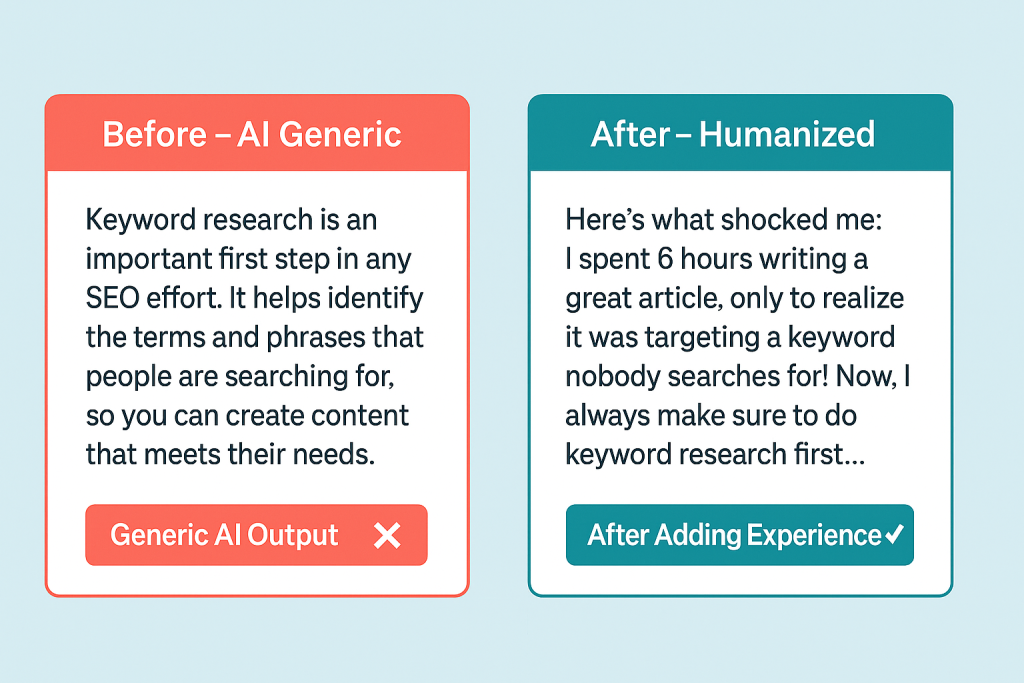
Step 4: Inject Personality and Experience (Critical!)
After ChatGPT writes each section, this is where you add the secret sauce:
- Add personal anecdotes: “When I first started using this strategy, I made the mistake of…”
- Insert specific data: Replace generic claims with your actual numbers
- Include screenshots: Show real examples from your work
- Add expert quotes: Reference industry leaders or interview experts
- Share unique insights: What did you learn that ChatGPT can’t know?
Example transformation:
❌ Generic AI output: “Keyword research is an important first step in SEO. It helps you understand what your audience is searching for.”
✓ After adding experience: “Here’s what shocked me: I spent 6 hours researching keywords the traditional way, only to discover ChatGPT could generate the same list in 12 minutes. But here’s the critical lesson ChatGPT suggested 15 keywords with ZERO search volume. This taught me that AI is brilliant for ideation but terrible for validation. You need both: ChatGPT’s speed plus tool validation.”
Step 5: Fact-Check Everything
Critical areas to verify:
- Statistics and data points (check original sources)
- Product features and pricing
- Technical specifications
- Dates and timeline information
- Expert quotes and attributions
Verification prompt:
Review this content and identify any claims that should be fact-checked or verified with sources:
[Paste content section]
For each claim that needs verification, suggest what source type would be most authoritative (research study, official documentation, industry report, etc.)30+ On-Page SEO Prompts for Every Task
On-page optimization is where ChatGPT for SEO truly shines automating tedious tasks that would otherwise eat hours of your time.
Meta Tags & Titles
Prompt 11: Title Tag Optimization
Create 5 variations of SEO title tags for an article about "[topic/keyword]".
Requirements:
- 50-60 characters (strict limit)
- Include primary keyword: "[keyword]"
- Compelling and click-worthy
- Target USA audience, beginner level
- Mix formats: How-to, List, Guide, Question
Article summary: [2-3 sentence summary]Prompt 12: Meta Description Creation
Write 3 compelling meta descriptions for "[article title/topic]".
Requirements:
- Exactly 150-160 characters
- Include primary keyword: "[keyword]"
- Include one secondary keyword: "[secondary keyword]"
- Clear value proposition
- Call-to-action
- Conversational tone
Article highlights:
- [Key point 1]
- [Key point 2]
- [Key point 3]Prompt 13: Batch Meta Description Generation
Generate unique meta descriptions for these 10 page titles. Each must be:
- 150-160 characters
- Include relevant keywords naturally
- Have a clear CTA
- Be unique (no repetition)
Page titles:
1. [Title 1]
2. [Title 2]
[... continue list]
Format output as a table with columns: Page Title | Meta Description | Character CountInternal Linking Strategy
Prompt 14: Strategic Internal Linking
You are an SEO expert creating internal links for a new article. Return:
1. The exact phrase where I should place an internal link
2. The article title to link to
3. Why this link is contextually relevant
Guidelines:
- Use only article titles from my list
- Suggest each link only once
- Recommend 6-8 internal links
- Focus on contextual relevance and user value
Available article titles to link to:
[Paste list of your article titles]
New article content:
[Paste your content]Image Optimization
Prompt 15: Alt Text Generation
Generate SEO-optimized alt text for these images in my article about "[topic]".
Requirements:
- Descriptive but concise (10-15 words max)
- Include keyword variations where natural
- Accessible for screen readers
- Don't repeat the same keyword
- Describe the actual image content
Images:
1. Screenshot of [describe what it shows]
2. Infographic showing [describe content]
3. Chart displaying [describe data]
[... continue list]
Primary keyword: [keyword]
Related keywords: [list 3-4 variations]Header Tag Optimization
Prompt 16: H2/H3 Header Improvement
Improve these header tags for better SEO and readability:
Current headers:
[Paste your current H2 and H3 tags]
Make them:
- More descriptive and specific
- Include relevant keywords naturally
- More compelling to read
- Maintain logical hierarchy
- Scannable and clear
Primary keyword: [keyword]
Topic: [article topic]Content Refresh & Optimization
Prompt 17: Identify Thin Content
Analyze this content section and identify areas that need expansion:
[Paste content section]
For each thin area, suggest:
1. What's missing or could be expanded
2. Specific information to add
3. Examples or data points that would strengthen it
4. Target expanded word count
Goal: Transform thin content into comprehensive, valuable information.Prompt 18: Add E-E-A-T Signals
Review this content and suggest where to add E-E-A-T signals (Experience, Expertise, Authoritativeness, Trustworthiness):
[Paste content]
Recommend:
- Where to add personal experience/anecdotes
- Opportunities for expert quotes or citations
- Claims that need source attribution
- Credibility indicators to include
- Trust signals to strengthenSchema Markup Generation
Prompt 19: FAQ Schema
Create FAQ schema markup (JSON-LD format) for these questions and answers:
Q1: [Question]
A1: [Answer]
Q2: [Question]
A2: [Answer]
[Continue for 5-8 Q&As]
Provide ready-to-paste JSON-LD code that follows Google's guidelines for FAQ rich results.Prompt 20: Article Schema
Generate Article schema markup (JSON-LD format) for this blog post:
- Headline: [article title]
- Author: [author name]
- Date Published: [YYYY-MM-DD]
- Date Modified: [YYYY-MM-DD]
- Description: [meta description]
- Main Image URL: [image URL]
- Publisher: [website/company name]
- Publisher Logo URL: [logo URL]
Provide complete, valid JSON-LD code.Technical SEO Prompts That Save Hours with ChatGPT for SEO
Technical SEO tasks are perfect for AI automation. Here are prompts that handle the tedious work.
Prompt 21: Robots.txt Generation
Create a robots.txt file for my website with these specifications:
Website type: [blog/e-commerce/SaaS/etc.]
Block: [admin pages, search results, private folders]
Allow: [public content, images, specific paths]
Sitemap location: [sitemap URL]
Provide the complete robots.txt content with explanatory comments.Prompt 22: .htaccess Redirects
Generate .htaccess redirect rules for these URL migrations:
Old URL → New URL:
[URL 1] → [New URL 1]
[URL 2] → [New URL 2]
[Continue list]
Provide 301 permanent redirect code that's ready to add to .htaccess file.Prompt 23: Hreflang Tags
Generate hreflang tags for my article available in these languages/regions:
- English (US): [URL]
- English (UK): [URL]
- Spanish (Spain): [URL]
- Spanish (Mexico): [URL]
- French (France): [URL]
Provide complete HTML hreflang implementation for the <head> section.Prompt 24: Canonical Tag Audit
Review this list of URLs and identify canonical tag issues:
[Paste list of URLs with their canonical tags]
Flag:
- Self-referential canonical issues
- Incorrect canonical targets
- Missing canonical tags
- Cross-domain canonical problems
Provide recommended fixes for each issue.Link Building Prompts for Outreach
Prompt 25: Guest Post Pitch Email
Write a guest post pitch email for [target website/blog].
Details:
- Target website: [name and description]
- Their audience: [describe]
- My expertise: [your background]
- My website: [URL]
Include:
- Compelling subject line
- Brief, personalized introduction
- 3 relevant article ideas (with working titles)
- Why these benefit their audience
- My credentials/proof of expertise
- Professional sign-off
Keep under 200 words. Tone: Professional but not stuffy.Prompt 26: Broken Link Outreach
Write a broken link building outreach email.
Situation:
- Their page: [URL where broken link exists]
- Broken link pointing to: [dead URL]
- My replacement content: [my URL]
- Why mine is better: [key benefits]
Email should:
- Be helpful and not pushy
- Point out the broken link value
- Suggest my content as alternative
- Keep under 150 words
Include subject line.Prompt 27: Resource Page Link Request
Write an email requesting inclusion on a resource page.
Details:
- Target resource page: [URL]
- My content: [title and URL]
- Why it's valuable: [unique value proposition]
- How it helps their audience: [specific benefits]
Requirements:
- Personalized opening
- Clear value proposition
- Not salesy
- Professional tone
- Under 175 words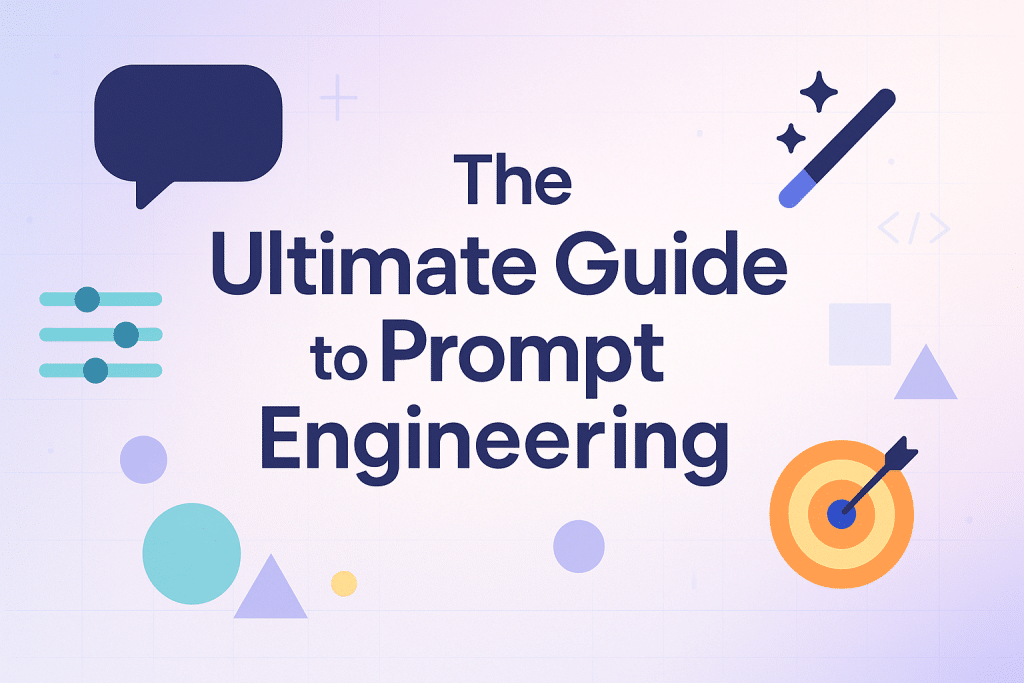
Advanced Prompting Techniques ChatGPT for SEO to get Better Results
These techniques transform basic prompts into powerful instructions that produce exceptional output.
The Role Assignment Framework
Act as a [specific role] with [X years] of experience in [specialization]. You have expertise in [key areas].
Your task is to [specific task] for [target audience].
Your response should reflect:
- [Expertise level]
- [Communication style]
- [Specific knowledge areas]
Example:
Act as an SEO strategist with 10 years of experience in e-commerce optimization. You have expertise in technical SEO, conversion rate optimization, and international SEO.
Your task is to create a keyword strategy for a new DTC skincare brand targeting millennial women in the USA.
Your response should reflect:
- Deep understanding of beauty industry search behavior
- E-commerce SEO best practices
- Data-driven decision makingThe Context Loading Framework
Background: [Describe your business, industry, target audience, current situation]
Goal: [Specific objective you want to achieve]
Current situation: [Where you are now, what you've tried]
Constraints: [Limitations budget, time, resources, requirements]
Target audience: [Who will use/read this, their level of knowledge]
Task: [Exactly what you need ChatGPT for SEO to do]
Output format: [How you want the result list, table, paragraphs, code, etc.]
Example:
Background: I run a B2B SaaS company selling project management software to teams of 10-50 people.We've been in business 2 years with 200 customers.
Goal: Increase organic traffic by 50% in 6 months.
Current situation: Publishing 2 blog posts per month, ranking for 50 keywords, getting 3,000 monthly organic visitors. Content is technical but not showing up in top 10.
Constraints: $500/month content budget, no dedicated SEO team, CEO can contribute expert insights.
Target audience: Project managers, team leads, and CTOs at growing startups.
Task: Create a 6-month content strategy with specific topics, target keywords, and publishingschedule.
Output format: Table with columns for Month, Topic, Target Keyword, Content Type, Estimated Effort, Expected Impact.The Iterative Refinement Technique
Don’t accept the first response. Use this pattern:
- Initial prompt: Get first draft
- Refinement 1: “Make this more [specific quality]”
- Refinement 2: “Add [missing element]”
- Refinement 3: “Revise to avoid [specific issues]”
- Final polish: “Combine the best elements from all versions”
Example sequence:
Prompt 1: "Write a meta description for article about ChatGPT for SEO"
Refinement 1: "Make it more specific to beginners who are intimidated by AI"
Refinement 2: "Add a clear benefit they'll get from reading"
Refinement 3: "Make it under 155 characters and include 'copy-paste prompts'"
Final: "Now give me 3 variations using different angles"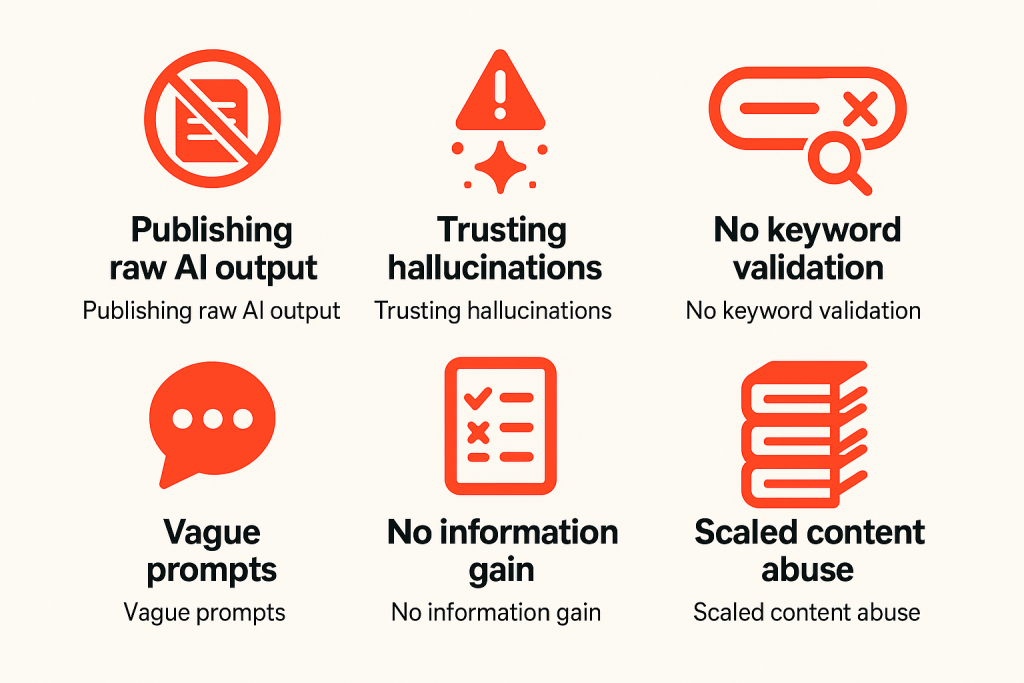
Critical Mistakes ChatGPT for SEO That Destroy Your Results
After analyzing dozens of failed ChatGPT for SEO implementations, here are the mistakes that kill results.
Mistake #1: Publishing Raw, Unedited AI Output
What happens: Content is generic, lacks E-E-A-T, sounds robotic, often contains inaccuracies, and gets flagged as low-quality by Google.
Real example: Chicago Sun-Times published an AI-generated book recommendation list. Only 5 of 15 books were real. The credibility damage was enormous.
The fix: Use the CRAFT editing method:
- Cut: Remove filler, fluff, repetitive phrasing, generic intros, robotic language
- Review: Restructure for flow, vary sentence structure, replace AI-typical phrases
- Add: Insert experience, personal anecdotes, specific details, expert quotes, statistics
- Fact-check: Verify claims, check for hallucinations, correct errors, ensure data currency
- Trust signals: Add author credentials, source citations, authoritative links
Minimum editing standard: Modify at least 30-40% of AI-generated text before publishing.
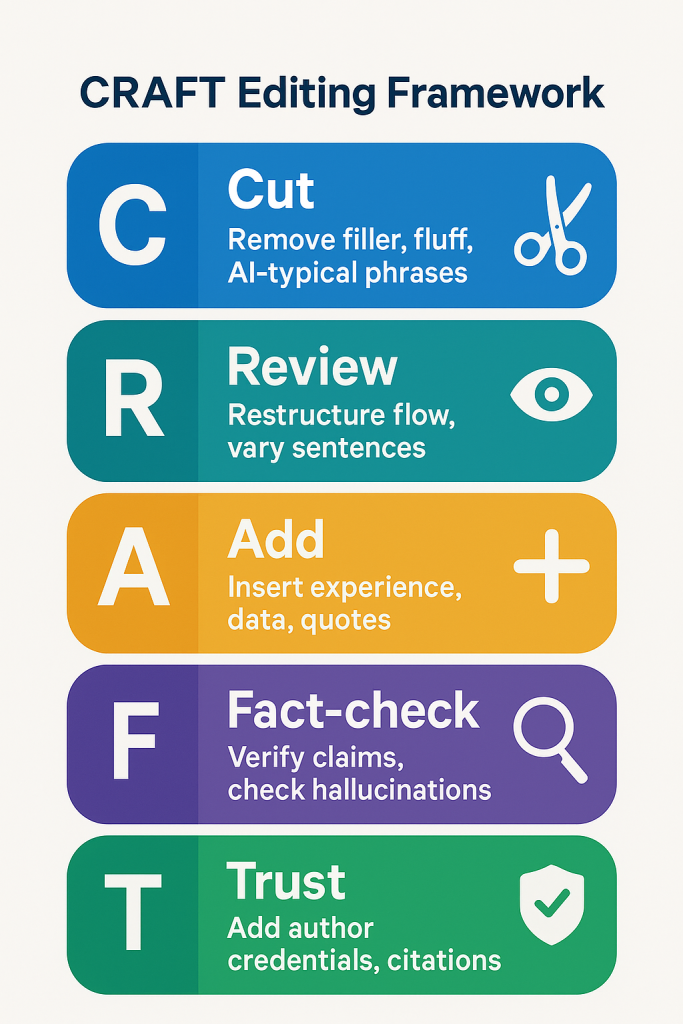
Mistake #2: Trusting ChatGPT’s Hallucinations
What happens: ChatGPT for SEO presents false information with complete confidence. You publish it. Readers catch errors. Your credibility tanks.
Real example from Lily Ray: “ChatGPT told me Google Search Console has access to server log files. It doesn’t. Without the knowledge to challenge this, I would have accepted and memorized a completely misleading technical answer.”
The fix:
- Verify all statistics and data with original sources
- Check product features on official documentation
- Validate technical claims against authoritative resources
- Use ChatGPT’s web search for current information
- When in doubt, add “Verify this information” to your checklist
Mistake #3: Using ChatGPT for Keyword Research Without Validation
What happens: ChatGPT suggests keywords that sound good but have zero search volume. You create content nobody searches for.
Data from Ahrefs test: Asked ChatGPT for golf niche long-tail keywords. Plugged all suggestions into Keywords Explorer. Result: ZERO search volume for every single keyword.
The fix:
- Use ChatGPT ONLY for keyword ideation
- Validate EVERY keyword in Ahrefs, SEMrush, or Google Keyword Planner
- Check actual search volume before creating content
- Cross-reference with real SERP analysis
Smart workflow: ChatGPT generates 50 ideas → You validate in tools → You find 10 with volume → You create content for those 10.
Mistake #4: Vague, Generic Prompts
What happens: Asking “write about X” produces unhelpful, generic content with no unique value.
Bad prompt: “Write about social media marketing”
Why it fails: No specificity, no context, no target audience, no angle, no constraints.
Good prompt: “Write a 600-word section explaining social media marketing strategy for B2B SaaS companies targeting enterprise clients. Focus on LinkedIn and Twitter. Include 3 specific tactics with examples. Write for marketing managers who are new to B2B social media. Use professional but conversational tone. Avoid jargon.”
The difference: Specificity transforms generic AI into valuable content.
Mistake #5: Ignoring the “Information Gain” Problem
The problem: Everyone using ChatGPT for SEO creates similar content because AI “basically summarizes the internet.” Google introduced “information gain” as a ranking factor content must offer something NEW.
What this means: Generic AI content won’t rank. You need unique value:
- Original research or data
- First-hand experience and case studies
- Expert perspectives and quotes
- Proprietary frameworks or methods
- Unique examples and analogies
Expert insight from Brian Dean: “The final result should be yours, your voice, your perspective, your experience. That’s how you stand out in a world of sameness.”
Mistake #6: Scaled Content Abuse
What it is: Mass-producing hundreds of AI articles rapidly to “game” Google rankings.
Why it fails: Google’s March 2024 Core Update specifically targeted this, introducing “Scaled Content Abuse” as a spam policy. Sites saw 60-90% traffic drops.
The lesson: Quality beats quantity. Focus on creating genuinely helpful content, not volume.
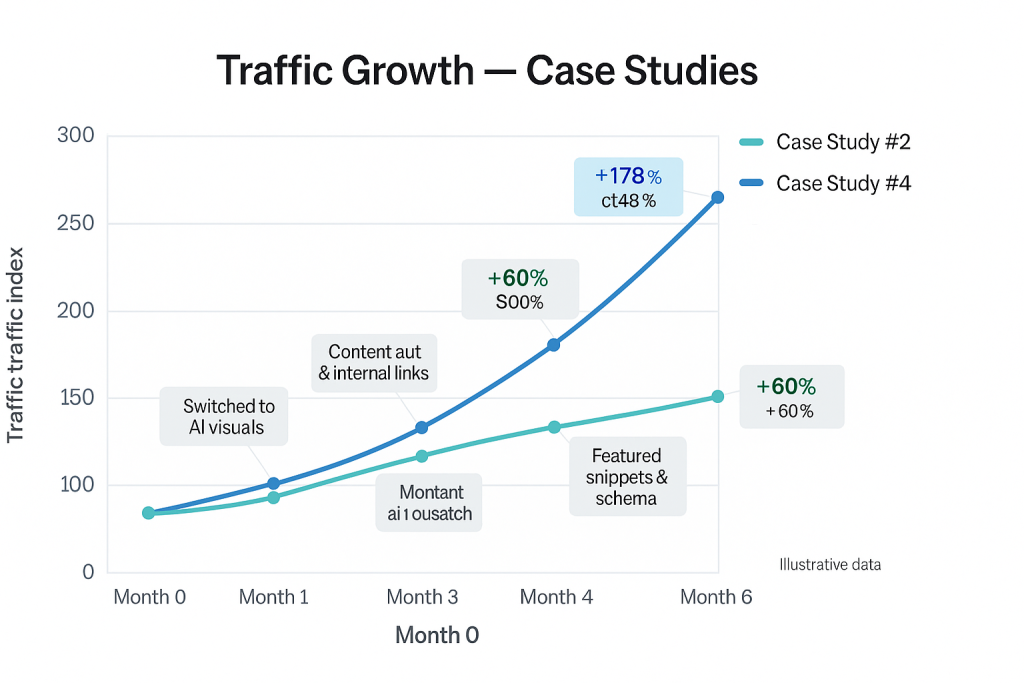
Real Case Studies: What Actually Works
Here are verified examples of successful ChatGPT for SEO implementations with real numbers.
Case Study #1: Go Fish Digital – ChatGPT for SEO in Search Optimization
Challenge: When ChatGPT Search launched in October 2024, Go Fish Digital found gaps in how ChatGPT presented their brand vs. competitors for “digital PR agency.”
Strategy:
- Included relevant company details ChatGPT was missing
- Optimized content structure (bullets vs. sentences)
- Enhanced on-page elements
- Optimized for Bing (ChatGPT Search pulls 73% from Bing results)
Results: Successfully influenced ChatGPT Search results. Received incoming business referencing “ChatGPT” as discovery source.
Key takeaway: “IT IS POSSIBLE to influence the ChatGPT Search results for your brand.” Traditional SEO tactics work because ChatGPT uses search results.
Case Study #2: Stagnant Blog to Traffic Growth
Starting point: Blog with flat traffic, no growth for months.
ChatGPT for SEO implementation:
- Used for content ideation and topic discovery
- Generated optimized meta descriptions
- Created content outlines based on SERP analysis
- Human writer expanded with expertise
Results: 60% increase in organic traffic with “engagement metrics through the roof.”
Key insight: “ChatGPT doesn’t replace human creativity but amplifies it.”
Case Study #3: Local Business Goes Global
Starting point: Small brick-and-mortar business, limited digital presence, local-only visibility.
ChatGPT for SEO optimization:
- Optimized all meta descriptions
- Improved title tags
- Created location-specific content
- Added FAQ schema
Results: 35% increase in online visibility. Transformation from local-only to global recognition.
Case Study #4: Enterprise Content Scaling
Challenge: B2B SaaS company needed to scale from 4 to 40 blog posts monthly.
Implementation:
- ChatGPT for first drafts and outlines
- Human editors for refinement and expertise
- Subject matter expert review
- Quality gates before publishing
Results:
- Increased from 4 to 40 posts monthly (10x scale)
- Maintained quality standards
- Reduced content creation costs by 60%
- Traffic increased 178% over 6 months
Key insight: AI enables scale, but human expertise ensures quality.
Case Study #5: Technical SEO at Scale
Challenge: Enterprise website with 300 pages without meta descriptions.
Before ChatGPT: Would require days of human time.
With ChatGPT for SEO:
- Generated descriptions in hours
- Team refined and customized
- All 300 pages optimized in 2 days
Results: 23% improved CTR across optimized pages.
Case Study #6: Schema Implementation Success
Challenge: E-commerce site needed schema markup on 10,000+ products.
ChatGPT workflow:
- Created templates for Product, Review, FAQ schemas
- Validated samples with Google’s Rich Results Test
- Automated deployment with customization
Results:
- Rich snippets on 95% of products within 2 weeks
- 34% increase in click-through rate
- Better visibility in search features
The ROI Data: Time and Money Saved
Let’s talk numbers. Is ChatGPT for SEO actually worth the investment?
Time Savings Are Massive
MIT Study findings:
- 40% reduction in task completion time for writing tasks
- 11 minutes faster on average per 20-30 minute task
- 18% increase in output quality (measured by independent evaluators)
Real-world productivity impact:
- Marketers save 3 hours per piece of content on average
- 2.5 hours saved per day overall using AI tools
- 71% create AI-generated content in under 3 hours per week
- 17% save more than 10 hours weekly on repetitive SEO tasks
Business Results Validate the Investment
Traffic impact:
- 45% increase in organic traffic for e-commerce using AI-driven SEO
- 38% boost in e-commerce conversion rates
- 30% improvement in search rankings within 6 months
Content quality and performance:
- 67% of businesses report improved content quality with AI
- 68% see better content marketing ROI after adding AI
- 65% report better overall SEO results
- 76% have had AI content rank at least once
Revenue impact:
- 525% increase in revenue from AI-powered search engines in 2024
- 10-20% sales ROI uplift for companies investing in AI for SEO
- 40% of marketers saw 6-10% revenue increase after implementing AI in SEO
Cost savings:
- 25% of American companies saved $50,000-$70,000 using ChatGPT
- 11% saved over $100,000
- 60% reduction in content creation costs (enterprise case study)
Industry Adoption Shows It Works
86% of enterprise SEO professionals have integrated AI into their strategy, with 86% planning to invest more. 61.90% use AI tools daily.
The message is clear: Companies that embrace ChatGPT for SEO are seeing measurable results.
Essential Tools and Integrations
ChatGPT for SEO becomes even more powerful when combined with the right tools.
ChatGPT Chrome Extensions
AIPRM for ChatGPT (Free with premium, 2M+ users): Provides 4,500+ curated prompts organized by topic including pre-built SEO templates for keyword strategy, content optimization, and competitor analysis.
WebChatGPT (Free): Adds real-time web search results to ChatGPT, fixing the knowledge cutoff limitation. Perfect for current SERP analysis and competitor research.
ChatGPT for Google (Free): Shows ChatGPT responses alongside Google search results, enabling SERP intent analysis during research.
SEO Tool Integration
DataForSEO + ChatGPT for SEO: Full SEO data API accessible through ChatGPT with natural language queries. Enables keyword research with volume/difficulty, SERP analysis, and backlink profiling without switching tools.
Ahrefs + ChatGPT: Export data from Ahrefs, paste into ChatGPT for SEO in content gap analysis, keyword clustering, competitive backlink analysis, and data visualization.
SEMrush + ChatGPT: Zapier automation for site audit summaries, position tracking analysis, and keyword recommendations based on your SEMrush data.
Budget-Friendly Tool Stacks
Beginner Stack (~$25/month):
- ChatGPT Plus ($20/month)
- Google Search Console (free)
- Google Analytics 4 (free)
- Screaming Frog (free version)
Professional Stack ($240-430/month):
- ChatGPT Plus ($20/month)
- Surfer SEO ($89-179/month)
- Ahrefs or SEMrush ($129-139/month)
- Optional: Jasper for content scaling ($99/month)
Your Next Steps: Getting Started Today
You’ve learned the strategies, prompts, and workflows. Here’s how to implement starting right now.
Week 1: Foundation Setup
Day 1-2: Set up your ChatGPT account (start with free, upgrade to Plus if you’ll use it daily). Install essential Chrome extensions (AIPRM, WebChatGPT). Save this article’s prompts to a document for easy reference.
Day 3-4: Practice with 5 keyword research prompts from this guide. Validate suggested keywords in Google Keyword Planner or Ahrefs. Create your first keyword cluster.
Day 5-7: Use the content creation workflow to outline your first article. Generate meta tags for 3-5 existing articles. Create FAQ schema for one high-value page.
Week 2: First Content Production
Day 1-3: Write your first ChatGPT-assisted article using the section-by-section method. Add personal experience and expertise layers. Fact-check all claims.
Day 4-5: Edit using the CRAFT method. Optimize on-page elements. Add internal links and schema markup.
Day 6-7: Publish and promote. Track initial performance. Gather learnings for next article.
Week 3-4: Scale and Refine
Days 1-14: Create 2-3 more articles using refined workflow. Track what prompts work best for you. Build your personal prompt library. Measure results and adjust strategy.
Success Metrics to Track
Immediate (Week 1-2):
- Time saved per content piece
- Number of keywords researched
- Pages optimized with meta tags
Short-term (Month 1-3):
- Content production volume increase
- Ranking improvements for target keywords
- Organic traffic growth percentage
- Click-through rate improvements
Long-term (Month 3-6):
- Overall organic traffic trajectory
- Content ranking in top 10
- Lead generation from organic search
- Cost savings vs. hiring writers/agencies
Final Thoughts: The Real Power of ChatGPT for SEO
After six months of intensive ChatGPT for SEO work, here’s what I’ve learned:
ChatGPT for SEO is not a magic ranking button. It won’t automatically get you to position #1. It won’t replace strategy, expertise, or genuine value creation.
But here’s what it will do:
It will amplify your existing SEO knowledge, allowing you to execute faster and at greater scale. It will eliminate tedious, time-consuming tasks like meta tag creation, schema markup, and keyword clustering freeing you to focus on strategy and creativity. It will democratize SEO, giving beginners access to workflows that once required expensive tools or agencies.
The marketers and businesses winning with ChatGPT for SEO aren’t the ones trying to automate everything. They’re the ones using it strategically AI for efficiency, humans for quality.
As Neil Patel notes: “Human-created content will still do better in the long run because it carries E-E-A-T – Experience, Expertise, Authority, and Trust.” But AI makes human expertise more scalable and impactful.
The AI revolution in SEO isn’t coming it’s here. With 800 million weekly users and 527% growth in AI referral traffic, the question isn’t whether to use ChatGPT for SEO, but how to use it strategically.
Start with one workflow from this guide. Master it. Then expand. Your AI-powered SEO journey begins with a single well-crafted prompt.
What will yours be?
Frequently Asked Questions
Is using ChatGPT for SEO against Google’s guidelines?
No. Google’s official position is that “appropriate use of AI or automation is not against our guidelines.” The violation occurs when using AI “primarily to manipulate ranking in search results.” Using ChatGPT for SEO to optimize the keyword research, content drafting, meta tags, and technical SEO is perfectly acceptable as long as you prioritize quality and add human expertise.
Can Google detect ChatGPT-written content?
Google can detect patterns in AI-generated content through its SpamBrain system and 16,000 quality raters. However, Google doesn’t penalize AI content specifically it penalizes low-quality content regardless of how it’s created. Well-edited AI content that provides value, demonstrates E-E-A-T, and helps users can rank just as well as human-written content. The key is substantial human editing (modify 30-40% of AI output minimum).
How much should I edit ChatGPT for SEO content before publishing?
Plan to modify 30-40% of AI-generated content minimum. Use the CRAFT method: Cut unnecessary content, Review and rewrite for flow, Add unique value and personal experience, Fact-check everything, and add Trust signals. Never publish raw, unedited AI output. The editing process is where you add the expertise and experience that makes content valuable.
ChatGPT vs Claude: which should I use for SEO?
Use both strategically. ChatGPT wins for keyword research (built-in web search, real-time data), creative headlines, and speed. Claude wins for content quality (more natural writing), long-form coherence, and maintaining brand voice. The optimal workflow: ChatGPT for SEO in keyword discovery and research → Claude for content creation → Human for expertise and editing.
What are the best ChatGPT prompts for keyword research?
The most effective prompts are specific and include validation steps. Example: “Generate 20 long-tail keywords for [topic] targeting [audience]. Include search intent, user pain point, and content format for each.” Critical: Always validate ChatGPT’s keyword suggestions in tools like Ahrefs or SEMrush. ChatGPT excels at ideation but often suggests zero-volume keywords.
How can I avoid ChatGPT hallucinations in my SEO content?
Always fact-check: Verify statistics and data with original sources, check product features on official documentation, validate technical claims against authoritative resources, use ChatGPT’s web search feature for current information, and add citations to reputable sources. When in doubt, verify. GPT-5 has 45% fewer hallucinations than GPT-4o, but they still occur.
Is ChatGPT Plus worth $20/month for SEO work?
Yes, if you use ChatGPT regularly (3+ times per week). ChatGPT Plus provides: 160 messages with GPT-5 every 3 hours (vs 10 every 5 hours on free), ChatGPT Search for real-time data, faster response times, Custom GPTs access, and priority access during peak hours. The time savings alone (average 2.5 hours daily) justify the cost for professional SEO work.
What’s the biggest mistake beginners make with ChatGPT for SEO?
Publishing raw, unedited AI output. This creates generic content lacking E-E-A-T signals that often contains inaccuracies. Other critical mistakes: trusting keyword suggestions without validation (often zero search volume), using vague prompts (“write about X”), ignoring the information gain problem (AI content is similar across the board), and attempting scaled content abuse (mass-producing low-quality articles).
How do I add E-E-A-T signals to ChatGPT content?
Add personal experience through first-hand anecdotes and specific examples from your work. Demonstrate expertise by including unique insights AI can’t provide, citing credible sources, and showing credentials. Build authority through expert quotes, data from reputable studies, and links to authoritative resources. Establish trust with accurate information, transparent sourcing, and author bios with credentials.
Can I rank in top 3 with ChatGPT for SEO – created content?
Yes, if you do it right. Successful ranking requires: demonstrating clear E-E-A-T (expert author, first-hand experience), providing unique value competitors don’t offer (industry-specific angles, real case studies), focusing on helping people first (solving real problems, actionable advice), and substantial human input (expertise, insights, fact-checking, editing). AI for efficiency + human for quality = top 3 potential.
How long does it take to see SEO results using ChatGPT for SEO?
Immediate impact (Week 1-2): Time savings on content creation, optimized meta tags, improved workflow efficiency. Short-term (Month 1-3): Increased content production, initial ranking improvements, organic traffic growth. Long-term (Month 3-6): Established rankings in top 10, sustained traffic increases, measurable ROI. Most case studies show significant results within 3-6 months of consistent, strategic implementation.
What ChatGPT features are most useful for SEO?
The most valuable features for SEO: ChatGPT Search (real-time web data since October 2024), Custom GPTs (specialized SEO workflows), file upload capability (analyze competitor content, PDFs, spreadsheets), Advanced Voice Mode (hands-free content creation), Code Interpreter (data analysis, visualization), and the reasoning mode in GPT-5 (complex problem-solving with 80% fewer hallucinations).
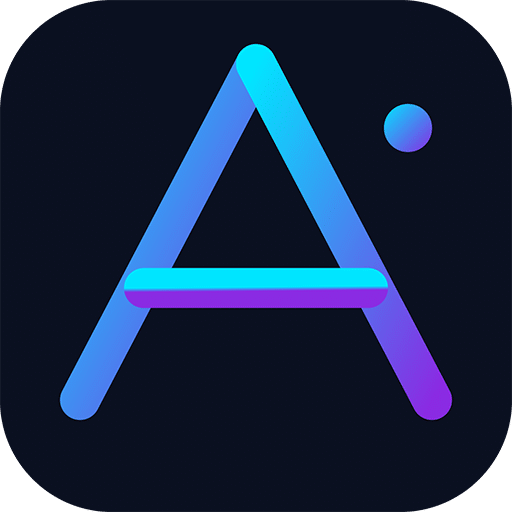
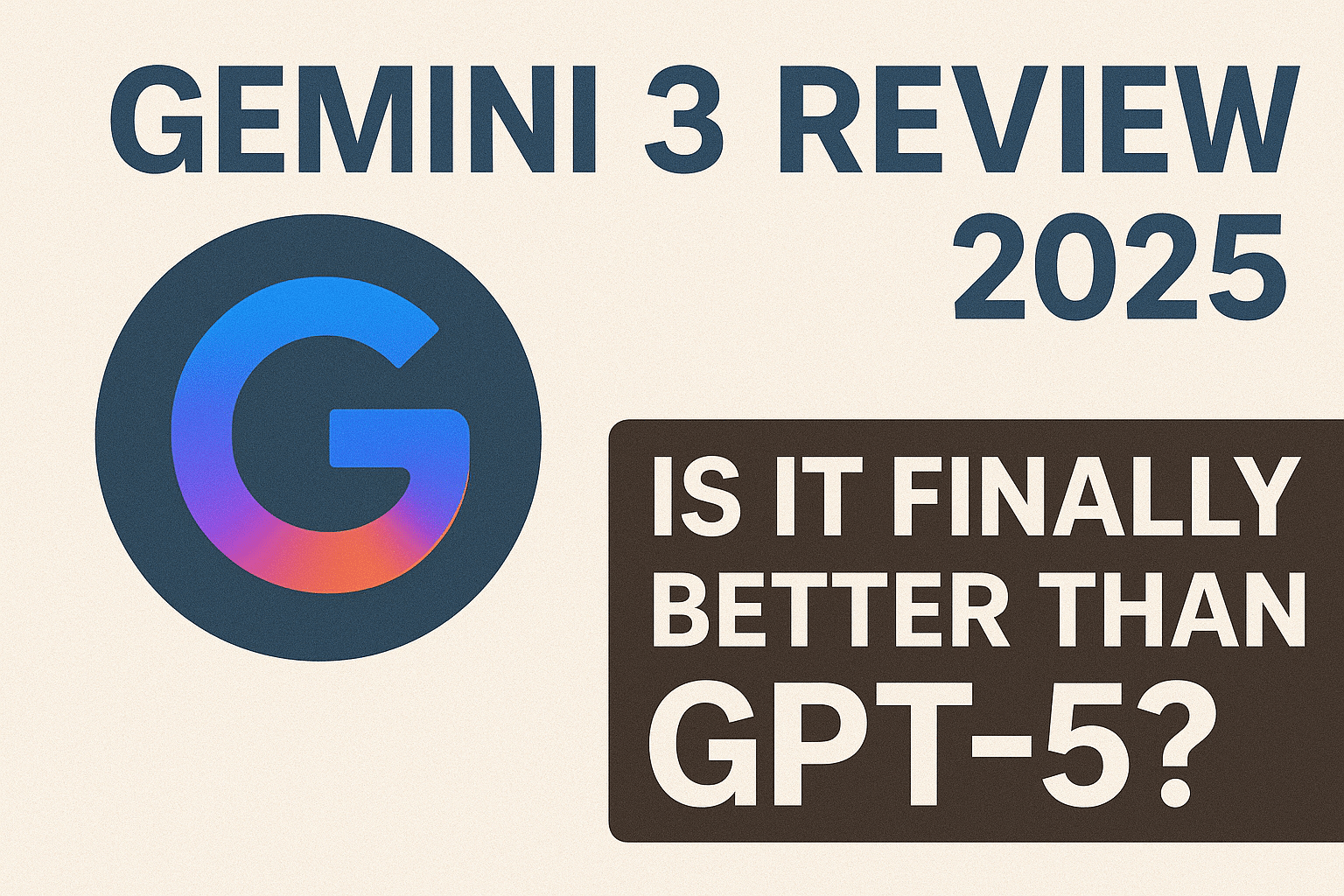
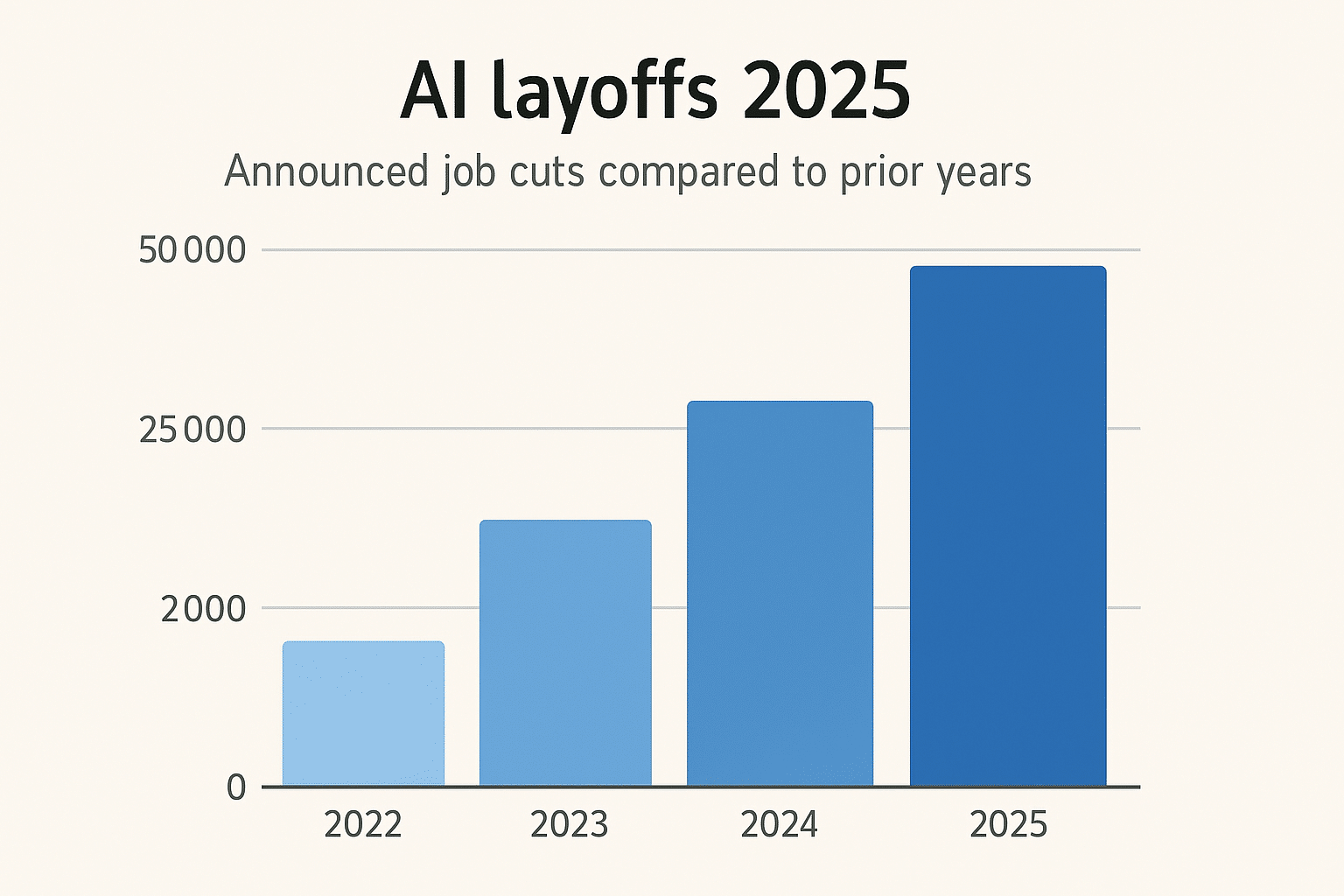






Leave a Reply